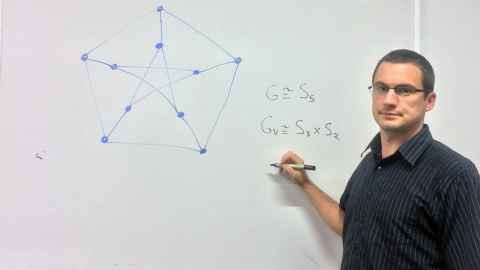Take 10 with... Gabriel Verret
Dr Gabriel Verret from the Department of Mathematics gives us 10 minutes of his time to discuss his research with graphs, and tackling a problem we all face: a dearth of time.

1. Describe your research topic to us ten words or less.
Highly symmetric graphs. [InSCIde Scoop note: The fewest words so far! Bravo Gabriel!]
2. Now describe it in everyday terms!
A graph is a mathematical structure used to describe a set of elements (called vertices), some of which are ‘related’ and others are not. For example, a network of cities or of computers, some of which are connected, or a set of people, some of whom are friends.
I study graphs which are highly symmetrical. For example, one may want every vertex in the graph to be ‘identical’ with respect to the structure of the graph. A typical graph will not have this property, but some graphs do, and this can be very useful.
3. What are some of the day-to-day research activities you carry out?
I’m trying to further our knowledge of these objects. Sometimes this involves trying to answer well-known questions about them, other times, it’s about trying to find new interesting avenues of research.
In practice, this is mostly done with pen and paper, and simply thinking about the problem, but computers play an increasingly large role. For example, when I have a new idea, I can sometimes use a computer to quickly check whether it has any chance of being correct.
4. What do you enjoy most about your research?
I enjoy the fact that I’m always learning new things. It’s also great to be at the ‘edge’ of human knowledge, to feel my contributions are something really new, even if it’s somewhat specialised.
Finally, I have a great network of colleagues and collaborators, here and throughout the world, which help make my research a great social experience as well.
5. How have you approached any challenges you’ve faced in your research?
When I was a graduate student or a post-doc, I was often able to reserve large continuous blocks of times to work on a particular problem. Between teaching and various other duties, this is much harder now. [InSCIde Scoop note: Ah, time, the great leveller – we feel your pain Gabriel!]
Being more efficient and experienced does compensate somewhat, but this is still a challenge, and has affected the way I work and even the problems I choose to work on.
6. What questions have emerged as a result?
I’m still trying to improve my time management to give myself more uninterrupted research opportunities.
7. What kind of impact do you hope your research will have?
While highly symmetric graphs do have some ‘real-world’ applications (for example, in designing the architecture of multi-core processors), my research is not immediately related to any of these.
I view it more as improving the state of our mathematical knowledge, for its own sake to some extent, but also because mathematical ideas often turn out later to be useful in quite unexpected ways.
8. If you collaborate across the faculty or University, or even outside the University, who do you work with and how does it benefit your research?
I love collaborating with others. Often just having an extra head, or somebody to bounce ideas off, can make a big difference. Sometimes I work with somebody who has a complementary set of skills, and we end up solving a problem which neither of us could have ever solved alone, which feels great.
9. What one piece of advice would you give your younger, less experienced research self?
I’m not sure I’d have much to say, partly because I was lucky enough to be surrounded by many more experienced researchers, who gave me lots of great advice already!